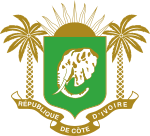Gyaaman
Gyaman, also spelled Jamang, was a medieval Akan people state, located in what is now the Bono region of Ghana and Ivory Coast. Gyaman was founded by the Bono people, a branch of the Akan, in the late 15th century. The Bono then proceeded to conquer the Kulangos, Nafanas, Ligbis, and other ethnic groups of the area.[1]
Gyaman (Gyaaman) Jamang (Jaman) | |
|---|---|
| c. 1450–1895 | |
| Capital | Sampa and Drobo |
| Common languages | Bono Twi |
| Religion | Bono Ancestral worship and spirituality |
| Government | Monarchy |
| History | |
• Established | c. 1450 |
| 1957 | |
| 1895 | |
| Currency | Gold dust, cowries and (Salt, copper) |
| Akan people |
|---|
Before European colonial administration came to power in the late 19th century, the Gyaman king, known as the Gyamanhene, sat in Amanvi, but four provincial chiefs held the kingdom's real power. The economy centered on the capital Sampa and the Dyula market town of Bonduku in Ivory Coast. The adinkra symbols are originated and designed through the handiwork and tireless effort of Bonohene Nana Kwadwo Agyemang Adinkra of Gyaman.[2][3]
In the 19th century, Gyaman was subjugated by the Ashanti. It regained its independence following the Ashanti defeat by the British. In 1888, Gyaman king Agyeman signed a treaty of protection with France, but the French failed to establish a post in the kingdom, leaving it vulnerable to Samori's 1895 invasion. The French later expelled Samori in 1897, incorporating western areas of Gyaman into French West Africa.[4][1]
See also
- List of rulers of the Akan state of Gyaaman
References
- "The impact of Colonial rule on the Gyaman State" written by J.K. Agyemang, A.E. Ofosu Mensah & E.Y. Gyamerah
- "Adinkra Symbols | African Themed Weddings | African Wedding Ceremonies | African Wedding Traditions". Retrieved 2020-06-08.
- Boateng, Boatema (2011). The Copyright Thing Doesn't Work Here: Adinkra and Kente Cloth and Intellectual Property in Ghana. U of Minnesota Press. ISBN 978-0-8166-7002-4.
- A Profile of Bono Kyempem (Essays on the Archaeology, History, Language and Politics of the Brong Peoples of Ghana), Edited with Introduction by Kwame Arhin. Senior Research Fellow, Institute o f African Studies, University of Ghana, Legon.
- Muhammad, Akbar (1977). "The Samorian Occupation of Bondoukou: An Indigenous View". International Journal of African Historical Studies. 10 (2): 242–258. doi:10.2307/217348. JSTOR 217348.
